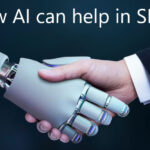
Artificial Intelligence (AI) has been transforming industries and revolutionizing the way we interact with technology. From autonomous vehicles to voice assistants, AI has become an integral part of our daily lives. However, traditional AI models often require substantial computational power and rely on cloud infrastructure, which can introduce latency and privacy concerns. This is where Edge AI comes into play, bringing intelligence and decision-making capabilities directly to the edge of the network. In this blog post, we will explore the concept of Edge AI, its benefits, and its applications across various industries.
Understanding Edge AI
Edge AI refers to the deployment of AI algorithms and models on edge devices, such as smartphones, Internet of Things (IoT) devices, and edge servers, rather than relying on centralized cloud servers for processing. By bringing AI capabilities closer to the data source, Edge AI reduces the latency and bandwidth requirements typically associated with cloud-based AI solutions.
Benefits of Edge AI
Reduced Latency
By processing data locally on edge devices, Edge artificial intelligence enables real-time decision-making without relying on a distant cloud server. This is particularly critical for time-sensitive applications, such as autonomous vehicles or industrial automation, where immediate responses are required.
Enhanced Privacy and Security
Edge AI mitigates privacy concerns by processing sensitive data locally, without the need to send it to the cloud. This is especially important for applications that involve personal or sensitive information, such as healthcare or financial services.
Bandwidth Optimization
Edge artificial intelligence reduces the amount of data that needs to be transmitted to the cloud for processing. This optimization helps alleviate network congestion and reduces bandwidth costs, making it an efficient solution for organizations dealing with large amounts of data.
Applications of Edge AI
Smart Cities
Edge artificial intelligence enables real-time analysis of data from various sensors deployed throughout cities, such as traffic cameras, environmental sensors, and infrastructure monitoring systems. This allows for efficient traffic management, energy optimization, and rapid response to emergencies.
Industrial Internet of Things (IIoT)
Edge artificial intelligence enhances the capabilities of IoT devices in industrial settings. By processing data locally, machines can make intelligent decisions on the factory floor, improving operational efficiency, predictive maintenance, and worker safety.
Healthcare
Edge artificial intelligence brings AI capabilities to medical devices and wearables, enabling real-time monitoring of vital signs, early detection of anomalies, and personalized healthcare recommendations. This technology can enhance patient care, reduce healthcare costs, and save lives.
Retail and Customer Experience
Edge artificial intelligence enables personalized recommendations and real-time analysis of customer behavior in retail environments. This helps businesses optimize inventory management, offer tailored promotions, and provide an enhanced shopping experience.
Autonomous Vehicles
Edge artificial intelligence plays a crucial role in autonomous vehicles by enabling real-time object detection, path planning, and decision-making. By processing data locally, vehicles can react swiftly to changing road conditions, improving safety and reliability.
Conclusion
Edge artificial intelligence represents a significant paradigm shift in the field of artificial intelligence. By bringing intelligence and decision-making capabilities to the edge of the network, it overcomes the limitations of traditional cloud-based AI solutions. With reduced latency, enhanced privacy, and optimized bandwidth usage, Edge artificial intelligence opens up new possibilities for a wide range of industries, from healthcare and transportation to manufacturing and retail. As technology continues to evolve, we can expect to see even more innovative applications and advancements that will shape the future of AI at the edge.













































Recent Comments